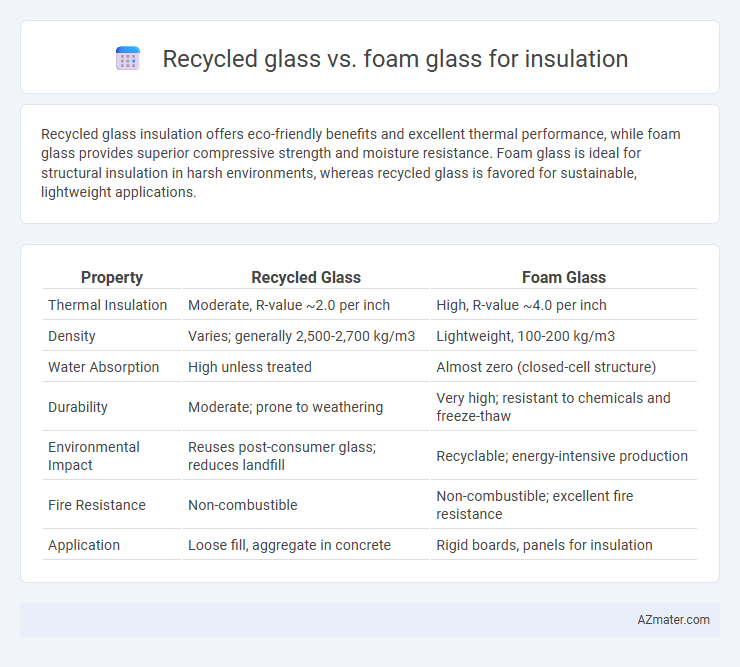Recycled glass insulation offers eco-friendly benefits and excellent thermal performance, while foam glass provides superior compressive strength and moisture resistance. Foam glass is ideal for structural insulation in harsh environments, whereas recycled glass is favored for sustainable, lightweight applications.
Table of Comparison
| Property | Recycled Glass | Foam Glass |
|---|---|---|
| Thermal Insulation | Moderate, R-value ~2.0 per inch | High, R-value ~4.0 per inch |
| Density | Varies; generally 2,500-2,700 kg/m3 | Lightweight, 100-200 kg/m3 |
| Water Absorption | High unless treated | Almost zero (closed-cell structure) |
| Durability | Moderate; prone to weathering | Very high; resistant to chemicals and freeze-thaw |
| Environmental Impact | Reuses post-consumer glass; reduces landfill | Recyclable; energy-intensive production |
| Fire Resistance | Non-combustible | Non-combustible; excellent fire resistance |
| Application | Loose fill, aggregate in concrete | Rigid boards, panels for insulation |
Introduction to Sustainable Insulation Materials
Recycled glass and foam glass are leading sustainable insulation materials renowned for their eco-friendly properties and thermal efficiency. Recycled glass insulation utilizes waste glass, minimizing landfill impact while offering excellent soundproofing and moisture resistance. Foam glass is a durable, non-combustible material with high compressive strength, ideal for environments requiring both insulation and structural support.
What is Recycled Glass Insulation?
Recycled glass insulation is a sustainable building material made from crushed glass that is repurposed into loose-fill or rigid insulation products, offering excellent thermal performance and soundproofing. This eco-friendly option reduces landfill waste and energy consumption compared to traditional insulation materials. Its high recyclability and resistance to moisture and mold make it ideal for both residential and commercial applications.
Understanding Foam Glass Insulation
Foam glass insulation, made from recycled glass, offers superior thermal resistance and moisture impermeability compared to traditional recycled glass insulation. Its closed-cell structure provides enhanced compressive strength and durability, making it ideal for foundations, roofing, and industrial applications where long-term stability is crucial. Foam glass also resists fire, mold, and pests, ensuring sustainable and efficient insulation performance in challenging environments.
Manufacturing Processes Compared
Recycled glass insulation primarily involves crushing post-consumer glass and melting it down before reforming into loose fill or rigid panels, leveraging lower energy compared to raw materials. Foam glass insulation is produced by grinding glass into a fine powder mixed with a foaming agent, then heating it to create a cellular, lightweight material with superior compressive strength. While both utilize recycled glass, foam glass manufacturing requires higher processing temperatures and specialized foaming steps, resulting in denser, more durable insulation with excellent moisture resistance.
Thermal Performance: Recycled Glass vs Foam Glass
Foam glass insulation offers superior thermal performance compared to recycled glass due to its closed-cell structure, which significantly reduces heat transfer and provides excellent resistance to moisture and thermal bridging. Recycled glass, while environmentally friendly and cost-effective, generally exhibits lower insulation values and less consistent thermal resistance because of its porous nature. The high compressive strength and low thermal conductivity of foam glass make it a preferred choice in applications requiring durable, energy-efficient insulation.
Environmental Impact and Eco-Friendliness
Recycled glass insulation significantly reduces landfill waste by repurposing post-consumer glass, leading to lower carbon emissions compared to foam glass, which requires energy-intensive manufacturing processes. Foam glass offers superior durability and moisture resistance but often relies on non-renewable raw materials and emits more greenhouse gases during production. Choosing recycled glass insulation supports circular economy principles and minimizes environmental footprint through sustainable material reuse and lower embodied energy.
Durability and Longevity of Both Materials
Recycled glass and foam glass insulation both offer excellent durability, but foam glass excels with its impermeability, resistance to moisture, and compression strength, leading to a lifespan of over 50 years in harsh environments. Recycled glass insulation, while sustainable and cost-effective, tends to have a shorter durability range due to its less robust structure and susceptibility to environmental wear. Foam glass's closed-cell structure ensures long-term thermal performance and prevents degradation, making it a superior choice for applications requiring extended longevity.
Application Areas and Suitability
Recycled glass and foam glass both serve as effective insulation materials, but their application areas and suitability differ significantly. Recycled glass insulation is ideal for residential and commercial wall cavities, attics, and soundproofing due to its lightweight, non-toxic properties and excellent thermal performance. Foam glass insulation excels in industrial and marine applications where high compressive strength, moisture resistance, and chemical inertness are critical for insulating pipelines, tanks, and cold storage facilities.
Cost Analysis: Initial and Long-Term
Recycled glass insulation typically offers a lower initial cost compared to foam glass, making it attractive for budget-conscious projects. Foam glass insulation, while more expensive upfront, provides superior durability, moisture resistance, and longevity, leading to reduced maintenance and replacement costs over time. Long-term cost analysis favors foam glass in applications where insulation performance and lifecycle expenses are critical factors.
Conclusion: Choosing the Right Insulation
Recycled glass and foam glass both offer excellent thermal insulation properties, but foam glass provides superior moisture resistance, compressive strength, and durability, making it ideal for demanding environments. Recycled glass insulation is more cost-effective and environmentally friendly, suitable for applications where budget and sustainability are top priorities. Selecting the right insulation depends on balancing performance requirements, environmental impact, and project budget to achieve optimal energy efficiency.

Infographic: Recycled glass vs Foam glass for Insulation
 azmater.com
azmater.com